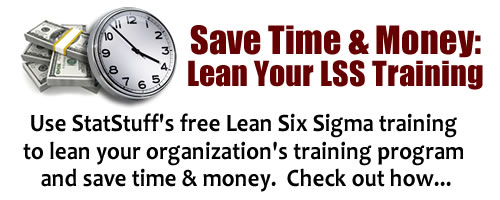| The most common tools and concepts that pertain to the Analyze phase of the DMAIC methodology of Six Sigma which is intended to help us apply analytical tests on the collected data for finding the root cause of the problem we're trying to solve. |
1. Analyze Phase Roadmap (Level 3)  
A detailed roadmap through the Analyze phase of the DMAIC methodology that navigates the user through the various tools and concepts for leading a Six Sigma project. |
2. Descriptive Statistics  
An introduction to some less common yet very useful statistics that help to describe the data we’re analyzing. |
3. Process Capability: Overview  
The first of a series of lessons about process capability; this lesson defines what process capability is and reviews a method for calculating it. |
4. Process Capability: Steps 1 - 3  
As part of a series about process capability, this lesson reviews the first 3 steps for following a method for calculating the capability of a process. |
5. Process Capability: Step 4 (Normal Dist)  
As part of a series about process capability, this lesson shows how to assess the capability of a process that’s based on a normal distribution. |
6. Process Capability: Step 5 (Non-Normal Dist)  
As part of a series about process capability, this lesson shows how to assess the capability of a process that’s based on a non-normal distribution. |
7. Process Capability: Step 6 (Binomial)  
As part of a series about process capability, this lesson shows how to assess the capability of a process that’s based on discrete or binomial data. |
8. Defining Performance Objectives  
A review of how to define the performance objectives based on the results of a process capability analysis. |
9. Hypothesis Testing: Overview  
An introductory overview to an extended series about hypothesis testing. This lesson includes the general 4 step process used for hypothesis testing. |
10. Hypothesis Testing: Formal & Informal Sub-Processes  
An extension on a series about hypothesis testing, this lesson builds on the prior 4 steps for hypothesis testing by looking at the 6 basic sub-steps. |
11. Hypothesis Testing: Statistical Laws and Confidence Intervals  
An extension on a series about hypothesis testing, this lesson introduces some statistical concepts that are fundamental to most hypothesis testing. |
12. Hypothesis Testing: Finding the Right Statistical Test  
An extension on a series about hypothesis testing, this lesson reviews a chart that can help you find the right statistical test for your analysis. |
13. Hypothesis Testing: Proportions (Compare 1:Standard)  
An extension on a series about hypothesis testing, this lesson reviews the 1 Proportion Test as a measurement of proportions. |
14. Hypothesis Testing: Proportions (Compare 1:1)  
An extension on a series about hypothesis testing, this lesson reviews the 2 Proportions Test as a measurement of proportions. |
15. Hypothesis Testing: Proportions (Compare 2+ Factors)  
An extension on a series about hypothesis testing, this lesson reviews the Chi2 Test (Goodness-of-Fit & Association) as a measurement of proportions. |
16. Hypothesis Testing: Cent Tend-Normal (Compare 1:Standard)  
An extension on a series about hypothesis testing, this lesson reviews the 1 Sample T test as a central tendency measurement for normal distributions. |
17. Hypothesis Testing: Cent Tend-Normal (Compare 1:1)  
An extension on a series about hypothesis testing, this lesson reviews the 2 Sample T & Paired T tests as central tendency measurements for normal distributions. |
18. Hypothesis Testing: Cent Tend-Normal (Compare 2+ Factors)  
An extension on a series about hypothesis testing, this lesson reviews the ANOVA test as a central tendency measurement for normal distributions. It also explains what residuals and boxplots are and how to use them with the ANOVA test. |
19. Hypothesis Testing: Cent Tend-Non Normal (Nonparametric Tests Overview)  
An extension on hypothesis testing, this lesson explains what nonparametric tests are and how they’re used for non-normal distributions. |
20. Hypothesis Testing: Cent Tend-Non Normal (Compare 1:Standard)  
An extension on hypothesis testing, this lesson reviews the 1 Sample Sign & Wilcoxon tests as central tendency measurements for non-normal distributions. |
21. Hypothesis Testing: Cent Tend-Non Normal (Compare 1:1)  
An extension on hypothesis testing, this lesson reviews the Mann-Whitney test as a central tendency measurement for non-normal distributions. |
22. Hypothesis Testing: Cent Tend-Non Normal (Compare 2+ Factors)  
An extension on hypothesis testing, this lesson reviews the Mood’s Median & Kruskal-Wallis tests as central tendency measurements for non-normal distributions. |
23. Hypothesis Testing: Spread (Compare 1:Standard)  
An extension on hypothesis testing, this lesson reviews the 1 Variance test as a measurement of spread or variation. |
24. Hypothesis Testing: Spread (Compare 1:1)  
An extension on hypothesis testing, this lesson reviews the 2 Variance test as a measurement of spread or variation. |
25. Hypothesis Testing: Spread (Compare 2+ Factors)  
An extension on hypothesis testing, this lesson reviews the Test for Equal Variances as a measurement of spread or variation. |
26. Hypothesis Testing: Relationships (Overview)  
An extension on hypothesis testing, this lesson introduces the concepts of a correlation and regression as part of measuring statistical relationships. |
27. Hypothesis Testing: Relationships (Compare 1:1)  
An extension on hypothesis testing, this lesson reviews the Pearson Correlation and Fitted Line Plot as part of measuring statistical relationships. |
28. Hypothesis Testing: Relationships (Compare 2+ Factors)  
An extension on hypothesis testing, this lesson reviews the multiple regression and GLM as part of measuring statistical relationships. |


